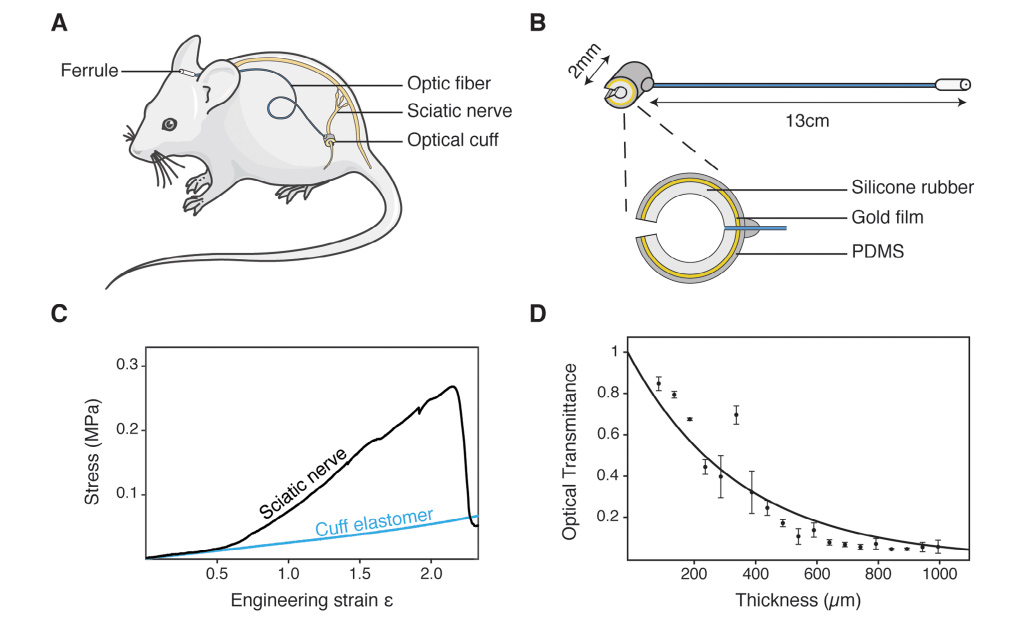Introduction
The objective of this study was to look at Nerves in the peripheral nervous system (PNS) that contain axons with specific motor, somatosensory and autonomic functions. Optogenetics offers an efficient approach to selectively activate axons within the nerve. However, the heterogeneous nature of nerves and their tortuous route through the body create a challenging environment to reliably implant a light delivery interface.
Approach
Here the research team proposes propose an optical peripheral nerve interface—an optocuff—, so that optogenetic modulation of peripheral nerves become possible in freely behaving mice. Using this optocuff, the research team demonstrate orderly recruitment of motor units with epineural optical stimulation of genetically targeted sciatic nerve axons, both in anaesthetized and in awake, freely behaving animals. Behavioral experiments and histology show the optocuff does not damage the nerve thus is suitable for long-term experiments. These results suggest that the soft optocuff might be a straightforward and efficient tool to support more extensive study of the PNS using optogenetics.
Nerve optical properties
Sciatic nerves of five naïve adult mice were carefully explanted after CO2 asphyxiation, immersed in PBS then embedded in 2.5% agarose gel. Cross-sectional slices (100–1000 µm thick) were obtained with a vibratome apparatus (VTS1200, Leica) and mounted on microscopic glass slides. A drop of saline was added to prevent slices from drying. Tissue transmittance was immediately measured with an optical system composed of a photodiode a power meter console and a 473 nm DPSS laser coupled to a multimode SMA optic fiber. The sensor was shaded with a mask matching nerve cross-section dimensions and a constant intensity illuminated the slices. The light radial distribution in sciatic nerve tissue was finally modeled using the modified 1D Beer–Lambert law: Where I0 is the optic fiber output irradiance, µeff the effective attenuation coefficient and z the slice thickness.
Optogenetic control and high-speed behavioural imaging
The optical cuff was coupled to the laser with a multimode FC/PC fiber optic cable using a ceramic mating sleeve on the ferrule. It was critical avoiding any physical stress on the mouse during the operation. Mice were housed in small chambers (7.5×7.5×15cm3) chambers and acclimatized for at least 30 min. A counter-balance lever arm (Harvard Apparatus) relieved the mouse from the laser optic fiber cable weight. A computer-controlled pulse generator (OPTG-4, Doric) was used to supply TTL signals to the laser driver. Simultaneous epineural optogenetic stimulation (average 40 mW laser output) and high-speed recordings were performed. Behaviour was sampled at 1000 frames per second using an acA2040-180kmNIR cameralink CMOS camera with an 8 mm lens and set at 500 pixels × 350 pixels. Acquisition was carried out in LabVIEW on a computer with excess buffer capacity to ensure all frames were successfully retained. Littermate control mice without Cre recombinase and implanted with the optical cuff did not react to blue light pulse (20 ms, 60 mW). Cuff implanted Thy1-Cre::ChR2 mice did not respond to an equivalent off-spectra pulse of light 593.5 nm.

Conclusion
In summary, soft optocuffs are a simple and efficient tool to probe the PNS with optogenetics. Its manufacturing does not require extensive microfabrication processes. Further miniaturization and addition of a wireless head-mounted light source would allow for an even broader use of the implant, especially to study smaller nerves, such as autonomic and visceral nerves. Finally, the optocuff system supports optogenetics as a versatile tool to unravel the PNS function, an essential step with therapeutic outcomes in many diseases, such as chronic pain.
Full access to the materials and methodology, can be found by clicking here.
Details on the 473 nm NIR Laser used in the research can be found by clicking here.